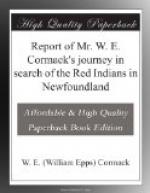We now determined to proceed towards the Red Indians’ Lake, sanguine that, at that known rendezvous, we would find the objects of our search.
Travelling over such a country, except when winter has fairly set in, is truly laborious.
In about ten days we got a glimpse of this beautifully majestic and splendid sheet of water. The ravages of fire, which we saw in the woods for the last two days, indicated that man had been near. We looked down on the lake, from the hills at the northern extremity, with feelings of anxiety and admiration:—No canoe could be discovered moving on its placid surface in the distance. We were the first Europeans who had seen it in an unfrozen state, for the three former parties who had visited it before, were here in the winter, when its waters were frozen and covered over with snow. They had reached it from below, by way of the River Exploits, on the ice. We approached the lake with hope and caution; but found to our mortification that the Red Indians had deserted it for some years past. My party had been so excited, so sanguine, and so determined to obtain an interview of some kind with these people, that, on discovering, from appearances every where around us, that the Red Indians—the terror of the Europeans as well as the other Indian inhabitants of Newfoundland—no longer existed, the spirits of one and all of us were very deeply affected. The old mountaineer was particularly overcome. There were every where indications that this had long been the central and undisturbed rendezvous of the tribe, where they had enjoyed peace and security. But these primitive people had abandoned it, after having been tormented by parties of Europeans during the last eighteen [Sic: thirteen] years. Fatal rencounters had on these occasions unfortunately taken place.
We spent several melancholy days wandering on the borders of the east end of the lake, surveying the various remains of what we now contemplated to have been an unoffending and cruelly extirpated people. At several places, by the margin of the lake, are small clusters of winter and summer wigwams in ruins. One difference, among others, between the Boeothick wigwams and those of the other Indians is, that in most of the former there are small hollows, like nests, dug in the earth around the fire-place, one for each




